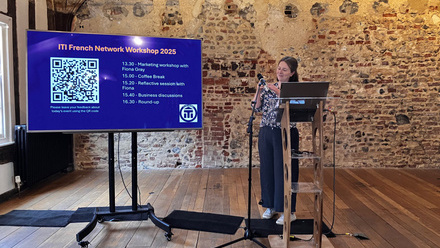Collaborating for a Sustainable Future
In recent years, the ITI has taken good steps to foster collaboration with academic institutions. As evident in the blogs by its Chief Executive Sara Robertson (e.g., Sara’s blog dated 5 June 2025), the ITI recognises that in an increasingly complex and fragmented professional landscape, working with academia is part of the solution for the sustainable future of the profession of translation/interpreting. The ITI is being actively involved in research initiatives and public engagement projects alongside universities.
For instance, the ITI has used its newsletters and blogs to promote initiatives with academic partners, signalling a commitment to knowledge-sharing and mutual benefit. In my view, this is a development that benefits all stakeholders, and it is crucial for building a sustainable future for the profession.
A compelling illustration of this collaboration is the recent medical checklist project launched by UCL’s Centre for Translation Studies. Led by Professor Federico Federici, with my involvement as co-investigator, this project brings together healthcare professionals, membership associations, certified medical interpreters, and academics. Combining Delphi surveys and semi-structured interviews to produce evidence-based recommendations for real-world application in NHS settings, the project’s ultimate goal is to develop a checklist to improve interpreter-mediated medical consultations within the NHS.

The government’s Office for Health Improvement and Disparities (OHID) has pointed out the need of providing quality public service interpreting to migrant patients. At the beginning of its latest guidance for this, the OHID cites the General Medical Council to state that ‘all possible efforts must be made to ensure effective communication with patients. This includes arrangements to meet patients’ communication needs in languages other than English.’ In 2023, the BBC revealed in its File on 4 programme that in the five years preceding 2023, at least 80 babies had died or suffered serious brain injuries in NHS maternity units in England, where interpreting and communication problems due to language barriers were a contributing factor.
While both the OHID guidance and the BBC programme show the essential importance of quality interpreting services to patients with limited English proficiency, a key area that merits examination is the extent of ‘effective communication with patients’ as referred to in the OHID guidance. I believe that for interpreter-mediated communication between doctors and patients in consultations, effective communication with patients not merely relies on good interpreters, but also on how well doctors are informed of such communicative processes. This stance is supported by an NHS report in 2024 that recommends ‘national training programs for healthcare staff on language barriers and communication strategies.’
Our medical checklist project is a response to this recommendation. We believe it is a big step forward to facilitate effective communication with patients who do not speak a mainstream language (which is English in our project) or only have limited proficiency in it, for health professionals to provide quality health care. As a public service interpreter, I still remember my first interpreting job years ago, in a hospital in China that treated foreign sailors. The doctor took me to his consultation room without so much as an introduction. The patient, understandably, looked at me with surprise, and even with a bit of suspicion. It was not until I explained that I was there as an interpreter that he slowly let his guard down. During that session, both the doctor and the patient only looked at me when speaking --- never at each other. The whole interaction felt as if I was at the centre, rather than the patient. This experience made me realise how crucial it is for medical professionals to be trained in collaborating with interpreters. If the doctor had taken a moment to introduce me and understood how interpreter-mediated consultations should flow, the patient would likely have felt more at ease, and the communication would have been centred around him, not me.
In my ten years of teaching Public Service Interpreting (PSI) to Master’s students at the University of Westminster (2006 to 2015), I made it a point not just to teach public service interpreting, but also to raise awareness of how medical consultations should unfold. My guidance to my PSI students was that interpreters can and should play an initiative-taking role in ensuring effective doctor-patient communication, especially when healthcare providers may not follow the best practices outlined in current guidelines. I believe public service interpreting in health is about creating a space where patients feel seen, heard, and cared for. This begins with informed interpreters and informed health professionals working together.
Existing guidance such as that of the OHID as aforementioned offers valuable information in this sense and is helpful. However, relevant documents are often too long and complex to be of immediate use in a time-pressured clinical setting, given high patient demand and a workforce crisis as stated by the government. When a patient is arriving in 10 minutes, most doctors do not have the luxury to scroll or sift through pages of documentation.
This is where our project steps in. We are developing a practical, user-friendly checklist specifically for busy doctors and nurses. Based on findings from our Delphi surveys and semi-structured interviews, the checklist will include up to ten key points to guide health professionals. It will be clear, concise, and focused on what matters most. It fits on a single sheet of paper. Doctors and nurses can print it and hang it in their consultation rooms for quick reference. They only need to glance and check before a patient needing an interpreter arrives. This will undoubtedly help them streamline care without compromising quality.
The ITI has provided substantial support for our checklist project. It has contacted medical interpreters to encourage participation, invited feedback from its executive committee, and shared project updates via its communication channels. In so doing, the ITI is helping shape a future in which professional practice and academic inquiry inform and strengthen one another. It is energising to see the relationship between professional associations and academic institutions develop into such a vibrant two-way exchange.






